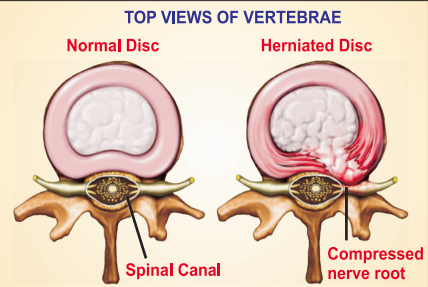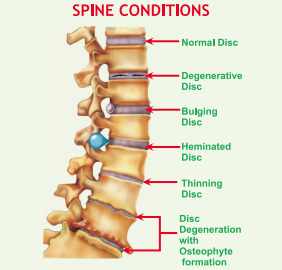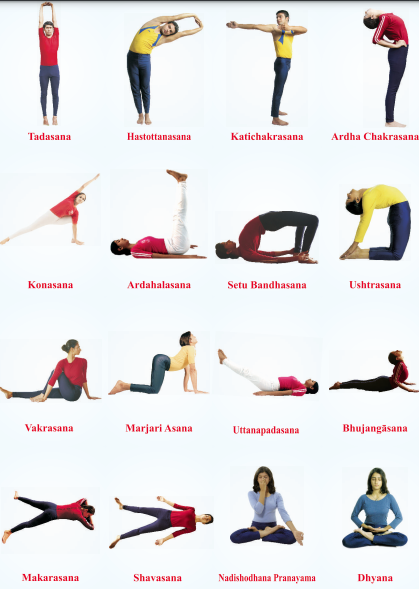Yogic Management of Low Back Pain
Yogic Management of Low Back Pain
Low Back Pain
 Most people may experience low back pain at certain stages of their life span. It is characterized by pain, stiffness and tension in the back. This pain can vary from mild to severe depending on duration, It can be short-lived or long-lasting. However, low back pain can make everyday activities difficult to perform.
Most people may experience low back pain at certain stages of their life span. It is characterized by pain, stiffness and tension in the back. This pain can vary from mild to severe depending on duration, It can be short-lived or long-lasting. However, low back pain can make everyday activities difficult to perform.
The low back pain is the most common cause of job-related disability and a leading contributor to missed work. Chronic back pain is a major cause of social and financial concerns as it is associated with impaired quality of life, loss of productivity and large health care expenses. Acute or short-term low back pain generally lasts from a few days to few weeks. Most acute back pain is mechanical in nature, as a result of trauma to the lower back or due to disorders such as arthritis. Pain and strain may be caused by a sports injury, work around the house or in the garden, or a sudden jerk such as car accident or other stress on spinal bones and tissues.
Many health care professionals have recognized that selected treatments commonly labeled complementary or alternative therapies (CAM) have the potential to help patients with chronic low back pain. Yoga is the foremost mode of treatment preferred for low back pain.
Symptoms of Low Back Pain:
Non-specific low back pain is expressed by tension, soreness and/ or stiffness in the lower back region and some times it is not possible to identify the specific cause of pain. Several structures in the back, including joints, discs and connective tissues, may also contribute to symptoms.
- Pain in the lower back that moves down the buttocks into one or both of the legs may be symptom of sciatic.
- Soreness in the lower back, muscle weakness and tight muscles may be caused by a slipped disc. In case of slipped disc, the pain usually radiates down the leg.
- Lower back pain, buttock pain, neck pain, stiffness and pain in the sacroiliac joint (the joint that connects the pelvis to the spine) are all possible symptoms of ankylosing spondylitis.
- Pain in the joints (including the back) when walking and stiffness first thing in the morning are symptoms of arthritis.
- Neck pain and stiffness, headaches and lower back pain following an accident are common symptoms.
Cause of Lower Back Pain
Back is a complex structure made up of bones, muscles, nerves and joints that can often make it difficult to pinpoint the exact cause of the pain. Most cases of low back pain are not caused by serious damage or disease but by sprains, minor strains, minor injuries or a pinched or irritated nerve. Some of the common reason for low back pain are:
- Bending awkwardly or for long periods.
- Lifting, carrying, pushing or pulling heavyweights incorrectly causing sprain, strain or spasm in back muscle or ligaments.
- Sitting in wrong posture in chair for long periods.
- Twisting or over-stretching of back.
- Driving in a hunched position or driving for long periods without taking a break.
- Overuse of the muscles, usually due to sport or repetitive movements.
Risk Factors for Low Back Pain
Certain risk factors increase the chances of developing back pain. These include:
 Overweight : The extra weight puts pressure on the spine, muscles and ligaments, which may lead to compression of nerve or disc herniation.
Overweight : The extra weight puts pressure on the spine, muscles and ligaments, which may lead to compression of nerve or disc herniation.- Smoking : This may be due to tissue damage in the back caused by smoking or the fact that smokers tend to have unhealthier lifestyles than non-smokers.
- Pregnant : The extra weight of carrying a baby can place additional strain on the back.
- Medicinal : Long-term use of medication known to weaken bones such as corticosteroids.
- Stress : Stress is thought to cause tension in the back muscles, which can result in back pain.
- Depression : Back pain can make people feel depressed, which can sometimes result in weight gain, which leads to increase pain and worsening depression.
- Age : As age advances, bone strength, muscle elasticity and muscle tone tend to decrease. The disc begins to lose fluid, which decreases their ability to cushion the vertebrae and hence flexibility is reduced.
- Disorders : Most low back pain may also be caused by degenerative conditions such as arthritis or disc disease, osteoporosis or other bone disease, viral infections, irritation to joints and discs or congenital abnormalities in the spine.
Conditions Associated with Low Back Pain
Conditions that may cause low back pain and require treatment by a physician or other health care professionals include:
- Bulging disc (also called protruding, herniated or ruptured disc)
- Osteoporosis
- Skeletal irregularities
- Fibromyalgia
- Spondylitis
- Herniated Disc (slipped disc)
- Disc degeneration (Osteoarthritis in the spine)
- Lumbar spinal stenosis
- Spondylo-listhesis
- Pelvic Inflammatory diseases
Yogic Management of Low Back Pain
- Om Chanting and Prayer
- Spinal exercises : The simple spinal movements facilitate the practice of further range of Yogic techniques by loosening the joints and muscles
- Sukshma Vyayama : Kati-sakti-vikasaka (Strengthening the Back) 1, 2,3,4 & 5).
- Yogasanas : Tadasana, Urdhwa Hastottanasana, Katichakrasana, Ardhachakrasana, Konasana, Uttanapadasana, Setubandasana, Ushtrasana, Vakrasana, Marjariasana, Sarala Matsyasana, Bhujangasana, Shalabhasana, Makarasana, Shavasana
- Pranayama : Nadishodhana Pranayama, Suryabhedana Pranayama, Bhramari
- Special Practices : Yoga Nidra
- Dhyana (Meditation)
Tips to a Healthier Back
Following any period of prolonged inactivity, begin a program of regular low impact exercises. Yoga helps to stretch and strengthen muscles and improve posture. Low-impact exercises are appropriate for all age and are designed to strengthen lower back and abdominal muscle groups.
- Always do warm up before exercise or any other strenuous physical activity.
- Avoid sudden movements, which can cause muscle strain.
- Don't lean forward abruptly while standing or sitting. Try to keep the weight balanced on the feet while standing.
- At home or work, make sure the work surface is at a comfortable height.
- Sit in a chair with good lumbar support and proper position and height for the task. Keep the shoulders back and relaxed.
- Switch sitting positions often and periodically walk around the office or gently stretch muscles to relieve tension. If one must sit for a long period of time, rest the feet on a low stool.
- Wear flat shoes or low-heeled shoes with caushioned sole as they can help reduce the pressure on your back.
- Sleep on the side to reduce any curve in the spine. Always sleep on a firm surface.
- Don't try to lift objects that are too heavy. Keep the object close to the body. Do not twist when lifting.
- Maintain proper nutrition and diet to reduce and prevent excessive weight, especially weight around the waistline that taxes lower back muscles.
- Diet with sufficient daily intake of calcium, phosphorus and vitamin D helps to promote proper bone growth.
- Quit smoking. Smoking reduces blood flow to the lower spine and causes the spinal discs to degenerate.
- Try to reduce stress, anxiety and tension, which can all cause or worsen back pain as the stress contributes to the pain intensity.
- Avoid oily and spicy foods.
Yogic Practices for the Management of Low Back Pain

Last Modified : 8/24/2024
This topic gives complete Information related to D...
This topic provides information about Yogic Manage...
This topic provides information about Yogic Manage...
Provides information about Do’s and Don’ts of Yoga...
